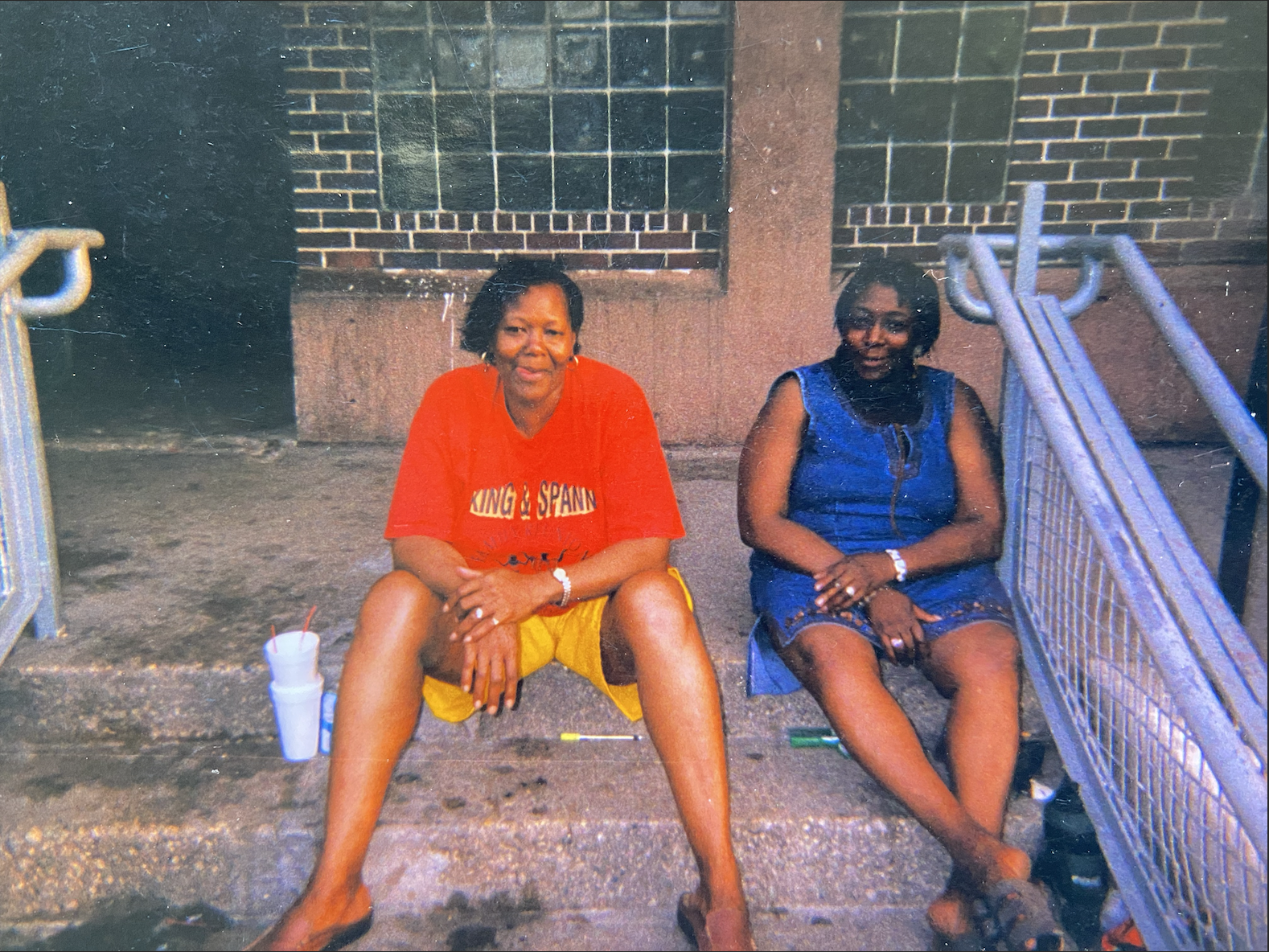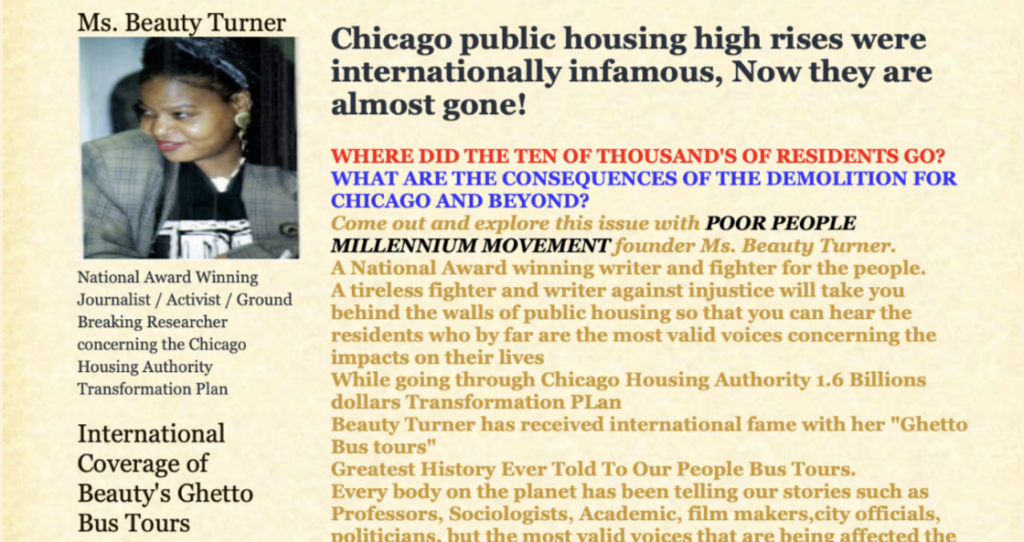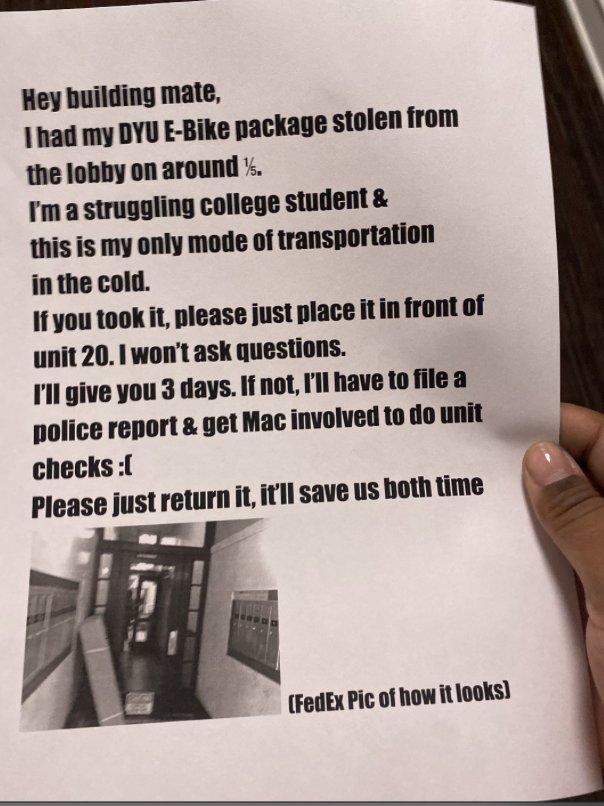Hey Love, Got Some Sugar?

by jellystone robinson with support from Liú Chen
My Granny with her best friend and cousin, my Aunt Ernestine sitting on the front porch of 511 E Browning Ave.
—The Ida. B. Wells E.X.T.s
This month, the National Public Housing Museum is celebrating the birthday of Ms. Beauty Turner, along with Black History Month, and Valentine’s Day. I’m drafting this a few days after my Granny’s birthday so I’m also taking this opportunity to celebrate her life and her love.
My Granny is Lucy Mae Frazier, mother to 3, grandmother to 11, and “it girl” of the Ida B. Wells E.X.T.s (at least in my eyes). She was a longtime member of the Local Advisory Council and president of our building—511—until it was demolished in 2011, according to her obituary.
I never knew my granny to have a lover, but she was never without love. She watched everybody’s kids and everybody’s grandparents too. Being over her house, you could always expect a knock on the door from somebody just wanting to talk. Her love for children inspired her to create the Wells E.X.T. Tutorial program (W.E.T) and she received an awards for her work with children in The Wells. She was my first example of a community organizer.
Beauty Turner was also an Aquarius, born during a waning crescent moon. In true Aquarius fashion, she was an innovator, a creator and a time traveler. Her blog, journalism work and Ghetto (Greatest History Ever Told To Our People) Bus Tours were capsules of humanitarian history.
The Ghetto Bus Tours, an experience where people who lived in the projects got to share what they chose to share, with people not from the projects, who either wanted a peek inside, wanted a change in perspective, maybe had a ancestor who lived there or maybe just wanted to say they’d been there.
For residents like me, her work (like the work of fellow memory workers and archivist) offers a road back ome, should concrete be as married to destruction as the words of a Chicago politician.

On Jan. 23, Ms. Beauty’s birthday, the National Public Housing Museum held a memorial luncheon in her honor. Larry Turner, eldest son of Ms. Beauty helped us create the perfect atmosphere to celebrate the birthday, life, and legacy of his mom and the honorary ancestor of our Beauty Turner Academy of Oral History (BTA), with soul food and pie, dusties, and love songs.
The memorial was beautiful and the food was too good! We were joined by an array of the National Public Housing Museum community, including Chalonda McIntosh (former Cabrini-Green Homes resident) of our Entrepreneurship Hub and Corner Store Co-op; Pierce Cruz (current Section 8 CHA resident) and Ashley Jefferson (current Section 8 CHA resident), graduates of the Beauty Turner Academy; Troy Gaston (former Robert Taylor Homes resident) of our Oral History Collective; and Dorothy Burge (former LeClaire Courts and Washington Park Scattered Sites resident), an accomplished “quiltivist” whose work will be featured in the window of the museum on Taylor Street. Beauty’s sister Maple Turner joined us by phone. A few other familiar faces also made an appearance, like Ron Carter, publisher and editor of Chicago Street Journal (formerly South Street Journal) and co-organizer of Ms. Beauty’s Ghetto Bus Tours in the late 90’s and early 2000’s.
Enjoy this visual recap of the event and some of the words of celebration shared by those who joined us.
Although I consider Beauty Turner to be a literary ancestor, I was not fortunate enough to meet her in this lifetime (at least not that I could remember). I felt so fortunate to hear from people who had firsthand experience hearing Miss Beauty say “Hey, Love…” It was a few days before I would begin a full time job here at the museum and I was an anxious wreck. Listening to Larry remind us of all the different ways “Hey Love” could be used, I spent more time than I’d like to admit wondering what it would’ve felt like to hear her say it to me on that day. I’m thankful for the fuel that came with hearing Larry repeat the words again and again and again.
My granny wasn’t very emotionally expressive of her love. She didn’t use many words. Sometimes, when I said “I love you,” she would answer with “Much love to you.” Like many Black ancestors, my granny expressed her love through a kind of work—paying attention, listening, and calmly, non-verbally, offering (not forcing) solutions.
When I was little, my nickname was ‘Anti’ because I was very quiet and would sooner hide behind my granny’s leg before talking to people. But I always loved people and yearned to come out of my cocoon of fear. My granny worked at an old folks home in Englewood, and one summer she started making me come with her to knock on people’s doors to do wellness checks. She expressed her love to me by introducing me to my elders, people who would not let me hide, who asked me to face them, to say hello to them and greet them with kindness and care. She taught me how to talk to my neighbors, how to ask for (and offer) sugar.
In Chicago, it’s 54 degrees in February and I’m writing this on my laptop at my neighborhood library. There is a man playing spades with bots on a computer and I’m wondering how to offer sugar. I wish I had a deck of cards and the confidence to find two opponents, sharing this space with us, who would quietly join us in sending cool breezes across the table. But I must work and the fan on my laptop will have to do for now.
There’s a package thief in my neighborhood. I’m not going to lie, I don’t care too much about packages being stolen from the mostly white people in Hyde Park who can afford to live in an apartment building where a 450 sq ft moldy studio is $1300. But sometime around Christmas 2023, I thought starting a package accountability group could be a good opportunity to start to build community with my neighbors, whose names I only knew from looking at their packages. Because I can’t afford the rent, I am moving soon. Maybe the grief of moving again is the reason I never got around to this little project of kinship that could satisfy a yearning deep in my heart to be closer to my community. A yearning perhaps shared by my neighbors. Last week, one of my neighbors sent us a letter after his package was stolen.

I couldn’t help but think of what could’ve been the alternative to this letter if I would’ve put my timidness aside to give my little idea life. I’m a Libra—so I know how to put timidness aside for love, or the possibility of it. I’ve put timidness aside to ask someone to be my valentine, I’ve put timidness aside to meet a lover’s parents. To share a first kiss with someone who made me feel the blood in my cheeks. Love teaches us to forgo timidness in the name of good feelings and more importantly, safety. To ask questions that might feel scary or too big to ask, but questions that nonetheless must be asked.
“Can I hug you?”
“Can I bring you dinner tonight?”
“Can I pick you up, just to ride around?”
Many of us seem most willing to do this for romantic love. I thought about how I could better practice forgoing timidness with my neighbors: the people I am both closest to and furthest from. How I’d wish my neighbors could show up for me, one of the only Black people living in this building in a historically Black neighborhood:
“I saw an eviction notice on your door, anything I can do to help?”
I decided to use the National Public Housing Museum’s 36 Questions for Civic Love toolkit to begin this practice. As the toolkit explains:
In 1997, psychologist Arthur Aron explored whether intimacy between two perfect strangers could be accelerated by asking each other a set of 36 questions. We adapted his questions for use in a new kind of social experiment, aimed at helping us all fall in civic love.
What is civic love? In her manifesto for 21st century activism, Detroit-based organizer Grace Lee Boggs implored, “We urgently need to bring to our communities the limitless capacity to love, serve, and create for and with each other.” It is from this directive that the National Public Housing Museum created its conception of Civic Love.
One of the questions that stood out to me the most was:
“Have you turned to your neighbors for help? Why? Why not?”
The weekend before Valentine’s Day, I decided to go out and ask my neighbors some questions in the Civic Love deck:
This experiment was pretty nerve wracking. Not nearly as romantic as it sounded in my head. But I love my neighborhood. I love my city and the people in it. And honestly this little slice of life audio clip might be one of my favorite places I’ve ever explored. So, I’m glad I did it.
This year, we’re kicking Valentine’s Day off with early voting on February 15th. One of the biggest issues on the bill Chicagoans are facing is the Bring Chicago Home ordinance. I encourage you to vote yes on question one. Here’s an excerpt with more info from an email from my friend cai thomas (who I actually happened to see during the Civic Love experiment!)
It’s a referendum to have a one time tax on properties sold over $1mil that would directly fund permanent housing for homeless folks. there’s currently 68k+ homeless folks in our city and of those 17k+ are cps students. if any one wants to chat more about this holler. early voting starts Feb 15th and election day is March 19th.
Since the passing of all of my grandparents, a little more than a decade after we were all displaced from our homes, I am learning to love my neighbors again. Since the pandemic started, I have been trying to practice loving better everyday. It can be easy to assume love is as simple as an emotion, but as bell hooks reminds us ‘Love is a verb, a combination of care, commitment, knowledge, responsibility, respect, and trust.” And Ursula K. Le Quin, “Love doesn’t just sit there, like a stone, it has to be made, like bread; re-made all the time, made new.”

I love this poem, and reading it reminds me of a quote that’s been circulating on Instagram about how grief is love enduring, love’s final form. I think about my Granny the most when I am experiencing something I love, and am unable to share it with her.
Between an ongoing and maybe never ending pandemic, multiple genocides, and a 40 hour work week, it can be easy to forgo love for fatigue. But Eve invites me to remember:
I have been touched by a blue sky while Lake Michigan massaged my scalp.
I have felt the mercy of a CTA bus driver’s smile when I didn’t have no money to get on the bus.
I have rested my head on the car window while my bestie got us safely to Ohio.
I have smelled my granny’s perfume in my building’s hallway after getting home from a too long Thursday.
This Valentine’s Day, it is really hard to write about love without writing about Bisan, Motaz, Lama, Love for Palestine, Sudan, Congo, Haiti, Tigray and so many more.
My international neighbors in Palestine have spent the last five months, fighting for their lives against global abuse in the forms of Genocide, Zionism, White Supremacy, Starvation, Covid-19 and victim-blaming. This is in the context of enduring decades or even centuries of imperialist violence and extractionism. Yet these international neighbors, even in total poverty, have sugar to offer the world.
I think of them everyday, when I see someone who looks like Bisan walking outside my window. When I think of my own 11-year-old sibling drowning in a press jacket.
Palestinian people’s love for their people, for their homes, and for their land and culture has contributed to what I imagine, what I hope: more love poems being written now than ever before. I hope you will join me in praying for a ceasefire, for the end to the occupation today and forever, for a free Palestine.
How has your interpersonal love supported your capacity for community love?
There are so many uncertainties we are collectively facing. In the midst of that, I thank you for your eyes and ears and thoughts about love. And I thank Granny Lucy and Ms. Beauty, and so many other caring elders and ancestors for raising a generation of people who won’t can’t be afraid to love our neighbors.
@notwildlin A beautiful love story
♬ original sound – NotWildlin
If you’re looking to explore some of the themes talked about in this blog further here are some reads, watches, listens, and events:
- spaces of grief, spaces of exception – Fatimah Ashghar
- Jupiter Magazine: Issue 001
- All About Love – bell hooks
- Ghosts in the Schoolyard – Eve Ewing
- The Slowdown – To Be in Love – Gwendolyn Brooks read by Ada Limón
If you’re looking for events to swoon in community this February, check these out:
- Bending Light Exhibit – Saturday, February 10 –April 27
- Kara Walker: Back of Hand Exhibition Opening – Thursday, February 15, 5–8pm CST
- French Wedding Caribbean Style Film Screening – Friday, February 16, 7–9pm CST
- Jupiter Magazine: No One Is Going To Mythologize My Life: Eve’s Bayou by Kasi Lemmons: Film Screening – Sunday, February 18
- TAPS Dance Program: Open DJ Dance Session – Sun, Feb 18, 6:30pm CST
- Spilling Over: Music Inspired By The Art Of Bob Thompson – February 22, 8pm CST
- Black Moon Trio: Spilling Over: Music Inspired by the Art of Bob Thompson – Thursday, February 22, 8pm CST
- Jamila Woods Live in Concert!! – Friday, February 23
- Rashid Khalidi in Conversation with Chicago Activists Bill Ayers & Ricardo Gamboa – Saturday, February 24, 6–10pm CST
- Chicago Safe Soils: Seed Swap – Saturday, February 24, 12–3pm, 4544 S Ashland Ave, Chicago, IL 60609
- We’re Still Here: 70th Anniversary of Glendale Townhomes
- Sister Social: Free Chicago Bulls Tickets! – February 28, 4pm

And if you just want to vibe out, the lovely staff at the National Public Housing Museum has taken the liberty of sharing some of their favorite love songs in the playlist linked below. One of my favorites is Practice by Jamila Woods.
